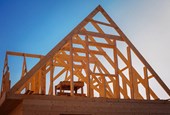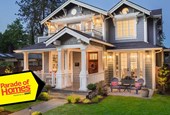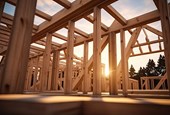
2015 is projected to be another big year for the home building industry in Minnesota and western Wisconsin. If you’re thinking of building a home this year or in the future, check out the top five building and green home trends.
A modern kitchen with plenty of room
Homes with open floor plans have been gaining popularity for over a decade, but nowhere is additional space desired more than in the kitchen. Many new homes have large areas off the kitchen for entertaining or informal dining and kitchen islands are important for separating the spaces.
To best incorporate green practices into these large spaces, builders are increasingly adding skylights to kitchen areas to draw in plenty of natural light. Cork kitchen floors are also gaining popularity – the natural spring of a cork floor is better on feet than tile and it resists mildew and mold. Plus, it’s an unexpected texture that automatically adds personality to any home.
Large garages, complete with space for a “man cave”
Even if a homeowner only has two cars, they likely have a need for an additional garage stall (or two) to store additional items. Many new homes have at least three stalls, but that’s not the most surprising thing about them. Increasingly, new garages are heated, insulated and include an area or stall that’s fully finished, too. The rise of the “man cave” is real – many of these garages include wiring for cable, Internet and electricity for the ever-important mini-fridge.
Solar energy is on the rise
Solar paneling has been gaining in popularity for years, but recent developments make solar energy even more affordable than in the past. Of course, one benefit of solar power is that the initial cost is quickly eclipsed by its output of natural energy. Let your homebuilder know that you’d like to use solar energy early on, so they can find the best placement for the panels on the home and for your specific lot. Also, remember to check with your builder or REALTOR® about green energy grants you maybe eligible for during the building process or tax breaks you could take advantage of in the next year.
Incorporating sustainable materials
We already mentioned cork as a great flooring option, but there are many other sustainable materials making a grand entrance into home décor and construction. Bamboo is another popular flooring surface; because bamboo grows much faster than wood, it’s considered a greener resource. It’s also as easy to clean as hardwood floors – usually a quick sweep will do the trick. Many buyers are also looking into Kirei, a composite board made of Japanese straw that can be used in furniture, cabinetry, as a backsplash and more.
Locally sourced materials can be expensive, but they will add a special touch to a newly built home. Most builders and interior decorators will know what stone, wood or local lumber is available and ready for incorporation in homes. Ask them before you begin the design process so you have the most options.
Building a smart home
One major part of being green is keeping utility costs down. New smart home features help homeowners use only the energy they need. These products include thermostats that can be controlled remotely or sprinkler systems that only water when the lawn needs it. See more examples of smart home features.
Tiny houses – no, really tiny houses
The tiny house movement is a direct result of The Great Recession. Some new construction buyers have shied away from large new homes, in favor of teeny-tiny homes that are often under 200 square feet. In many ways, tiny houses blend the minimalist feel of Ikea and the efficiency of a mobile home or houseboat. Tiny houses are usually one room, with a loft acting as the only sleeping quarters. A small, covered front porch acts as a great place to eat dinner or read. Other efficiencies include benches that double as storage and shelves with open, decorative storage (think flour, sugar and brown sugar in mason jars).
Tiny houses are green for obvious reasons – they require almost no heat or electricity to run, and are incredibly cheap to make. This tiny house site says that when the homeowners build one on their own, the cost can be under $23,000.
While they’re not for everyone, the tiny house movement is a great reminder that most of us can get by on less. Many home builders are now more conscious of this desire than before the recession and have building plans that incorporate more storage and multi-use space.
Make it your own
The whole point of building a brand new home is to customize it to your exact specifications. So whether you’d like a home with a five-car garage or a tiny house, you can always add green home features to the areas you’d like, while keeping other areas more traditional. Edina Realty’s New Construction division has building experts all over Minnesota and western Wisconsin. Reach out today to be connected with an agent who will help you find the right development, lot and builder for you and your family.









 ©2025 Prosperity Home Mortgage LLC®. (877) 275-1762. 3060 Williams Drive, Suite 600, Fairfax, VA 22031. All first mortgage products are provided by Prosperity Home Mortgage, LLC®. Not all mortgage products may be available in all areas. Not all borrowers will qualify. NMLS ID #75164 (For licensing information go to: NMLS Consumer Access at
©2025 Prosperity Home Mortgage LLC®. (877) 275-1762. 3060 Williams Drive, Suite 600, Fairfax, VA 22031. All first mortgage products are provided by Prosperity Home Mortgage, LLC®. Not all mortgage products may be available in all areas. Not all borrowers will qualify. NMLS ID #75164 (For licensing information go to: NMLS Consumer Access at